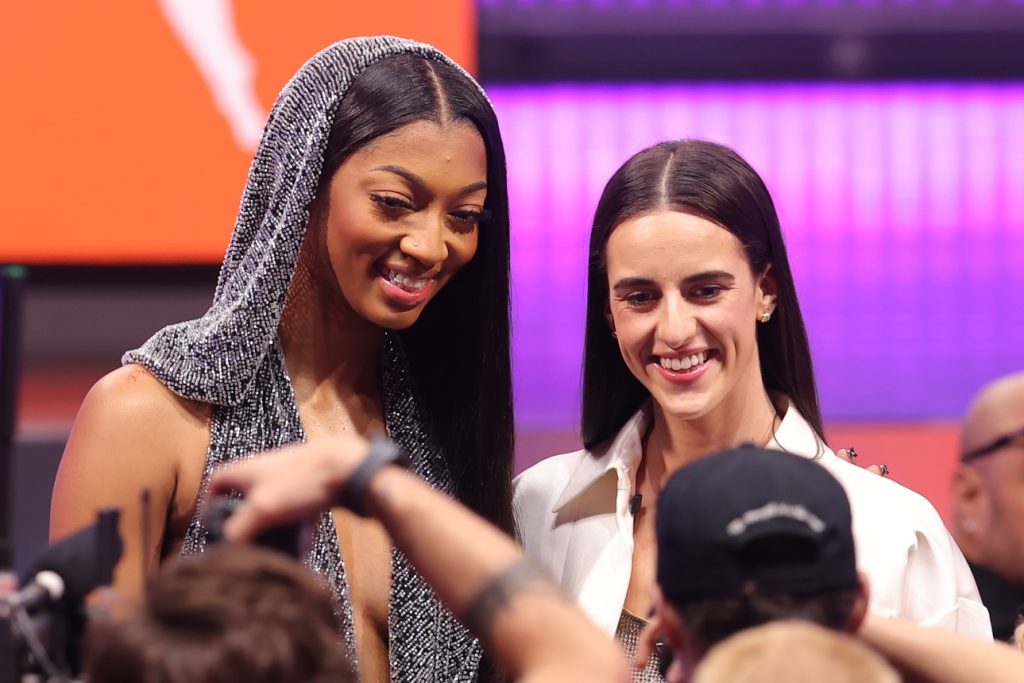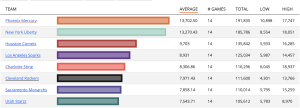With the first pick in the 2024 WNBA draft, the Indiana Fever select Caitlin Clark, University of Iowa.
With the seventh pick in th2 2024 WNBA draft, the Chicago Sky select Angel Reese, LSU.
WNBA Commissioner Cathy Engelbert announced the draft picks that would change the WNBA landscape forever.
 Credit: Brad Penner-USA TODAY Sports
Credit: Brad Penner-USA TODAY Sports
Caitlin should be grateful she makes $16 million off the court because without the platform the WNBA gives her, she wouldn’t make anything… players should be on their knees thanking their lucky stars for the media rights deal that I got them.
WNBA Commissioner Cathy Engelbert’s alleged comments on Caitlin Clark and the league’s growing revenue from its newly agreed-upon 11-year, $2.2 billion media rights deal with Disney, NBCUniversal, and Amazon, ahead of the league’s collective bargaining agreement’s expiration.
Fans were shocked, not only by the callousness of the comments but also by what seemed to be the delusion in Engelbert’s alleged comments. Which begs the question: Was she right?
The truth about the WNBA ratings surge
Clark and Reese’s arrivals in 2024 were accompanied by an astronomical boost in television ratings and game attendance, right?
Let’s start at the beginning. The W was founded in 1997, 27 years before the arrival of Caitlin Clark and Angel Reese, with 8 teams, and its first season was, by all accounts, a resounding success.
Attendance averaged 9,661 in 1997, courtesy of Acrossthetimeline.com.
Average attendance in 2024, now with 12 teams in the league, paints a not-so-different picture, at 9,807.
2025 showed a jump, up to 10,986, although still not as staggering a one as you may have thought, and interestingly enough, attendance was led by the Golden State Valkyries in their inaugural season, a team that notably features neither Angel Reese nor Caitlin Clark.
An interest in the league from its inception is also evident in its television ratings.
The WNBA was officially founded and approved by the NBA Board of Governors on April 24, 1996, and was collectively owned by the NBA until the end of 2002. The league’s inaugural game took place on June 21, 1997, between the New York Liberty and Los Angeles Sparks, and was broadcast by NBC as a resounding success, as it “topped all Saturday afternoon sports shows,” tipping the league off with 5.04 million viewers.
Fittingly, Clark and Reese opened the 2025 season against each other 28 years later on May 17, in what was again must-see television.
The game, a blowout 93-58 win for the Fever, averaged 2.7 million viewers on ABC, and peaked at 3.1 million viewers, via Sports Media Watch.
Reese and Clark are undoubtedly fueling growth, but the numbers show that abundant interest in the league has been rampant since its inception. So, where does the (glaringly wrong) narrative that nobody cares about women’s basketball stem from?
Enter Mark Shapiro
 Credit: CNBC
Credit: CNBC
Shapiro joined ESPN in 1993 in an entry-level role as a production assistant. In 2001, he accepted a role as a senior vice president and general manager of programming, and by 2002, he’d become the executive vice president for programming and production, putting him in charge of the Worldwide Leader in Sports’ programming and setting up a clash with then-NBA commissioner David Stern.
In 2002, the NBA, which oversees the WNBA’s media rights negotiations to this day, saw its media rights transferred to Disney, which owns ESPN, bringing Stern and Shapiro to the negotiating table to determine in which capacity both leagues would be broadcast by the network.
Mark Shapiro wanted nothing to do with one of them.
“I told (Stern) the WNBA stinks, it doesn’t rate, and I didn’t want it. No one watches it. Men don’t watch it. Women don’t watch it! My goal was to get it off the air,” Shapiro detailed in Those Guys Have All the Fun: Inside the World of ESPN.
“We amped up the number of women’s college basketball hours because at least there’s a demand and an audience for that. The WNBA didn’t have either. I told that to Stern, and he hated me for it. I wanted it off altogether, but he went above me… At least I got it put on ESPN2, where it couldn’t hurt us.”
For his part, Stern held firm and got a deal done, but Shapiro managed to bury the WNBA’s games on ESPN2.
“The overall quality of play wasn’t ready for the ESPN audience. The sponsor support wasn’t there. If they’d been on ESPN the way David Stern wanted, people would have left and never come back,” Shapiro said in an attempt ot justify his decision.
The consequences were damning.
As early as 2008, in a WNBA Finals series between the Detroit Shock and San Antonio Stars entirely broadcast on ESPN2, the numbers were abysmal. The series garnered around 315,000 viewers.
League attendance waned with the ratings. The 2008 campaign saw average attendance fall beneath 8,000, with the Chicago sky averaging a putrid 3,656.
So, how do we find ourselves in 2025, with the WNBA Finals back on ESPN averaging 1.5 million viewers.
Enter Magic and Bird Angel and Caitlin
Before the pair were selected first and seventh overall, respectively, the locomotive had already left the station. Caitlin Clark and Angel Reese had faced each other in the two previous renditions of the NCAA tournament.
Reese’s Tigers won the first matchup 102-85 in the 2023 National Championship, leading Reese’s now-infamous “You can’t see me” taunt toward Clark that still energizes each fanbase today.
Clark’s Hawkeyes got their revenge in their 2024 rematch, ending Reese’s collegiate career with a 94-87 win in the Elite Eight.
The momentum from their tournament clashes crashed the locomotive into the 2024 WNBA draft, and there was gold in the wreckage. That year’s draft smashed the previous year’s ratings with 2.4 million viewers, a 307% increase.
The impact was felt away from the television as well. Clark’s level of celebrity had already rivaled or surpassed any active basketball players not named LeBron James or Stephen Curry. Engelbert and the league responded by committing $50 million over the next two seasons toward providing full-time charter flights for its teams.
According to a 2024 study, the WNBA delivered a record $136 million in media value for sponsors in Reese and Clark’s rookie season.
That Caitlin Clark and Angel Reese have driven enormous growth in engagement for the league is undeniable. However, David Berri, a professor of economics at Southern Utah University, drew a comparison to Larry Bird and Magic Johnson to contextualize the WNBA’s growth in engagement.
Bird and Johnson were drafted in the late ‘70s by the Boston Celtics and the Los Angeles Lakers, respectively, and were credited with saving the league’s attendance woes.
However, Berri has found that the increase in attendance coincided with games becoming televised, a phenomenon he believes is now occurring in women’s basketball.
“Going back to the Larry Bird story, whoever was [first] showing up on NBA television on TNT and TBS in the mid to late ‘80s, they were going to be considered the major stars driving the story, but the real important story is that they were put on the television.”
Perfect timing isn’t the only parallel Clark and Reese share with the NBA’s legends of the ‘80s.
The rivalry between Johnson and Bird also started in the NCAA tournament before really catching fire in the NBA. The Lakers, Celtics rivalry went on to define the sport in the 80s.
The pair were dominant forces on each coast, stacking accolades en route to multiple championships, even facing one another in the NBA Finals three times.
As eminent as they were on the court, the rivalry was also driven by the undertones of race in America.
Bird was a white, technician of a sharpshooter, and played for ‘blue collar’ Boston. Johnson was a ‘showtime’ performance on the floor, black, and played in Los Angeles, one of the most diverse cities in the country. The Celtics certainly had black fans, and the Lakers had white ones, but the racial undercurrents of their fanbases and rivalry are indisputable.
Clark and Reese have also had dominant starts to their careers. Reese was named to the All-Rookie team and rebounding leader in each of her first two seasons of professional basketball. Clark was the 2024 Rookie of the Year and named to the WNBA First-Team. Both were All-Stars in each of their first two season.
They have also both found their rivalry to some extent, defined by America’s race problem, a problem heightened by the current administration and online landscape.
Indianapolis, where the Fever are centered, fancies itself a ‘midwestern blue-collar’ city. Chicago is one of the most diverse, and segregated, cities in the country, and has produced countless black celebrities that celebrate their ties to the city, including but not limited to former First Lady Michelle Obama, musician Chief Keef, and actress Lena Waithe.
Clark, like Bird before her, has mastered the three-point shot, especially going to her left, which opens the floor and unlocks a lethal playmaking ability. Even when Clark’s three-point shot is off, the attention that she commands from defenses is an invaluable asset to her teammates.
Reese’s game isn’t as polished as Clark’s, but its effectiveness can’t be ignored. Reese’s instincts and motor are second to none, which buys the Sky possession after possession on the offensive glass. As much flack as she might get for her trademarked mebounds (offensive rebounds from her own misses), the polish is coming along as well; her field goal percentage improved from 39.1% in her rookie season to 45.8% in 2025.
The cities they call home, their transcendent talent, and era’s divisiveness of not sown, but certainly watered and cultivated under figures such as Donald Trump and the late Charlie Kirk, has created a livewire.
Take the May 17th season opener between the Sky and Fever, which took place at Gainbridge Fieldhouse in Indianapolis. With 4:38 remaining in the third quarter, Reese snagged an offensive board after a three-point attempt, and rather than let her get up a clean put-back, Clark committed a hard foul to send her to the line.
Caitlin Clark’s push of Angel Reese led to her being called for a flagrant foul. Reese and Aliyah Boston received offsetting technical fouls on the play as well. pic.twitter.com/9HzulR9Euh
— Awful Announcing (@awfulannouncing) May 17, 2025
It’s basketball, play on. Right? Of course not, too simple.
The WNBA was forced to open an investigation into alleged hateful, racist rhetoric from Fever fans toward Reese at the game, and while ultimately, no evidence of such comments was found, the damage was done.
As so often is the case now, the truth, which is that racism is a key feature of the black experience in America, and that the WNBA, which is comprised of majority black players, needs to do a better job of protecting its athletes, regardless of what may or may not have been said at Gainbridge on May 17, did not matter. The damage was done.
The online rhetoric devolved into racist, sexist, hateful comments from both sides. Reese was ghetto and didn’t deserve to be in the league. Clark was only popular because she was white. Ignorant thinkpiece here. Misinformed thinkpiece there. So on and so on.
But the racial component of the rivalry cannot be downplayed. It drives interest in some cases, which means engagement, which turns into television audiences and ticket sales, but ultimately, it’s not the force driving the machine.
Race wars on Elon Musk’s X are not the driving force behind Engelbert’s media rights deals that the players should “be on their knees thanking their lucky stars” for.
The WNBA is more competitive than ever
It’s A’ja Wilson winning her fourth MVP and third WNBA Finals in what was for her a “down year.” It’s Napheesa Collier’s immaculate footwork on one end of the floor and stifling defense on the other. It’s Marine Johannes’s ability to make the impossible look routine.
And the talent is only improving. Notre Dame star Hannah Hidalgo has shown she can average 24 points on one end and be the best point-of-attack defender on the other.
Take this snatch-gather from LSU guard, and former Angel Reese teammate, Flau’Jae Johnson. Look familiar?
That’s because it’s a carbon copy of Cleveland Cavaliers guard Donovan Mitchell’s signature windmill gather.
And the competition will keep improving. As parents realize how financially viable an option women’s basketball has become, for better or for worse, the specialization training begins younger and younger.
Thanks to boots-on-the-ground social media presences like SSN Jay-O, we can see things like Annalese “Ace” Schroeder dominating with a Kyrie Irving-esque skillset in fifth grade.
@stonersportsnetworkssn Annalese “Ace” Schroeder Is The Best 5th Grade Girls Basketball Player In The World!! The Next Caitlin Clark?!?? #aceschroeder #hooper #buckets #middleschoolbasketball #womensbasketball #youthbasketball #ballislife #madehoops #nba #wnba #goat #aau #aaubasketball #2k #kyrieirving #stephcurry #bronnyjames #d1bound #espn #foxsports #nike #nikebasketball #adidas #buckets #hooper #overtime #handles #handlelife #crossover #hesi #girlsbasketball #caitlinclark #fyp #foryou #fypシ ♬ Calm – Faneo sound
But as great as they might be, the players still need Engelbert’s WNBA if they want to be seen, right? After all, at the end of the day, television audiences are the crux of all of this success. Wrong again.
WNBA stars are bigger than the league
Angel Reese made her Victoria’s Secret fashion show debut
(via @people /IG)pic.twitter.com/JljWN5G783
— Ballislife.com (@Ballislife) October 16, 2025
Angel Reese became the first professional athlete to walk the Victoria’s Secret Runway on October 15. The Studbudz (streaming duo of Minnesota Lynx players Courtney Williams and Natisha Hiedeman) will be successful wherever cameras are pointed at them.
Even with Reese and Clark missing significant time in 2025 due to injury, the WNBA experienced record viewership, averaging 1.3 million viewers across ESPN and ABC.
Then there’s the three-on-three-sized elephant in the room. The first season of Unrivaled, co-founded by Collier and Liberty star Breanna Stewart, and billed as an alternative to players having to play overseas in the offseason to supplement their salaries, was a resounding success.
The league’s inaugural season, broadcast on Max and TNT, averaged 221,000 viewers en route to bringing in $27 million in revenue. The WNBA has been content to co-exist with Unrivaled thus far, but if Engelbert and the league don’t value the players, why can’t it become a five-on-five operation that competes in the traditional fall/winter basketball window?
This brings us to the expiration of the current collective bargaining agreement and where things go from here.
These players aren’t just businesswomen, as Clark and Reese have shown; these women are the business.
“The amount of money that Caitlin Clark has made the league is insane, and she’s getting 0% of it because we have no revenue share. She gets less than $80,000 a year, and she’s bringing in, like, hundreds of millions of dollars. It’s insane,” Collier told Glamour magazine.
The NBA commissioner, Adam Silver, has been reluctant to support a revenue share model similar to the NBA’s.
“I think share isn’t the right way to look at it because there’s so much more revenue in the NBA,” he said on the Today Show.
Regardless of what Silver thinks the right way to look at the CBA negotiations is, or how intentionally ambiguous the league and owners choose to be with their revenue numbers, the train has left the station, and the players are the economic engine keeping it running.
They know it, we know it, and Cathy Engelbert knows it. On October 30th, the WNBA and the Players Association agreed to a 30-day extension on the current CBA, one day before it was set to expire.
Cathy Engelbert should be thanking her lucky stars they’re approaching negotiations in good faith, and agree to a fair revenue share before they decide they want to secure their own billion-dollar media deals.
Qwame’s debut novel, The First Casualty, an adult fantasy, is out now, and he thinks it’s great! If you enjoyed this article, it just might be worth your time to check that out as well.




